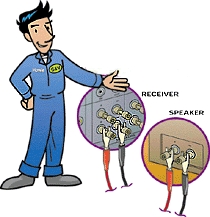The Setup: Speakers Page 2
|
|
Connections Are Everything This is not optional: The cables between your speakers and your receiver or amplifier must be connected in the correct polarity - that is, with the red (or +) terminal on the receiver going to the red (or +) terminal on the corresponding speaker, and the same with the black (or -) connections. (Speaker cables are usually either color-coded or have a ridge or markings on one side to make the matchup easy.) If you don't match the polarity at both ends, bass response and imaging will suffer.
Also, make sure your speaker cables are compatible with the connectors on both your receiver and speakers. Many inexpensive receivers and speakers use spring-clip connectors that don't accept the banana plugsor spade lugs found on some high-quality speaker cables. Binding postsaccept virtually any type of connector (except for some esoteric high-end types), including bare wire.
Symmetry, Imaging, and Soundstaging Stereo and multichannel speakers will not "image" properly - that is, place the singers and instruments consistently within the soundstage, each contributing to the overall mix from a specific distance and direction - unless they're set up as symmetrically as possible. The more nearly symmetrical your setup, the better the imaging and soundstaging you'll get.
Stereo speakers - and front left/right speakers in a multichannel setup - should be positioned like mirror images of each other, either facing straight out or "toed in" toward the listening position at the same angle. You should follow any placement recommendations from the manufacturer, but some don't supply any, so a good rule of thumb is to divide the wall behind the speakers into thirds and place them at the one-third and two-thirds points, then move them an equal distance out into the room.
 Stereo speakers and the left/right front speakers in a multichannel system should be set up as mirror images, either parallel to one another or "toed-in" at the same angle. If possible, they should be the same distance from the side walls and from each other. Use a tape measure to make these measurements precisely. To place the speakers, divide the wall behind them into thirds and put them at the one-third and two-thirds points. As shown in the diagram (left), your listening position should be at the point of an equilateral triangle. Stereo speakers and the left/right front speakers in a multichannel system should be set up as mirror images, either parallel to one another or "toed-in" at the same angle. If possible, they should be the same distance from the side walls and from each other. Use a tape measure to make these measurements precisely. To place the speakers, divide the wall behind them into thirds and put them at the one-third and two-thirds points. As shown in the diagram (left), your listening position should be at the point of an equilateral triangle. |
You may have to adjust these distances for the most satisfying results, but it's a good placement to start. If your room setup won't permit equal distances, get as close as you can. Use a tape measure when making these and other measurements - I'm not kidding when I say that differences of less than an inch will have an audible impact on imaging when you're using the highest-quality speakers. (Hard to believe, I know, but I've heard it happen.) Also note that the same rules apply whether the speakers are on stands or on the floor.
Take the room surfaces and furnishings into account as well. If one speaker in a left/right pair is next to a bare wall and the other is next to heavy drapes, the differences in how these surfaces absorb or reflect soundwaves will cause the two speakers to sound different, making accurate stereo imaging impossible. Use common sense, and adjust the room furnishings if necessary.
Speaker Placement Essentials Finding the right location for your speakers usually means striking a compromise between the best imaging, bass, and overall tonal balance. To determine the best place to listen from, create an equilateral triangle with the left and right speakers at two corners and your listening position at the third. To perform the listening tests I'm about to describe, select some music CDs you know are well recorded, or use one of those recommended in Setup Discs.
First, adjust the distance between the speakers. Start with the speakers facing straight out (we'll take care of the toe-in later). If they're too far apart, you'll hear a hole in the middle - that is, the sound will seem to collapse into the speakers, with a distinct lack of sound in the space between them. If they're too close together, the sound will become more monophonic, lacking stereo channel separation and a sense of depth. When they're placed just right, you'll hear a seamless, even sound field across the front of the room, even if the imaging and tonal balance aren't quite there yet.
 Your speakers must be hooked up to your receiver or amplifier with the cables connected in the correct polarity - that is, the red (+) terminal on the receiver goes to the red terminal on the corresponding speaker, and the same with the black (-) connections.
Your speakers must be hooked up to your receiver or amplifier with the cables connected in the correct polarity - that is, the red (+) terminal on the receiver goes to the red terminal on the corresponding speaker, and the same with the black (-) connections. 




























































